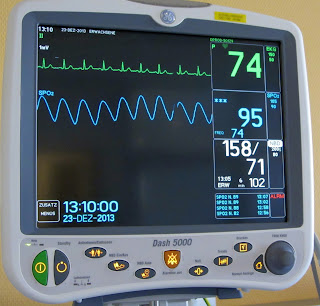Typically, Medical Monitors only display the Patient's Vital Signs. - This new Medical Monitor indicates Emotional Stress and/or Pain, too.
This new monitor provides an External Indicator e.g. colored lights to show the Internal Distress/Pain Condition of a person, e.g. a Patient - and provides a means to assist a person, e.g. a Patient, to Reduce their Distress/Pain by Relaxation Means, e.g. Deep, Slow Breathing.
See this Video to see How It Works, Theory of Operation, Applications, etc. - Medical Monitor with an Emotional Stress And/or Pain Indicator - Explanation Video.
***************************
There are two versions of this concept – one uses Skin Conductance or Galvanic Skin Response (GSR) and the other uses Heart Rate Variability (HRV).
******************************
This Blog Post shows how the make the Skin Conductance Version (GSR). (My Working Model is not for sale – but you can make your own – and make it even better than I did!)
The HRV version is being worked on and will be revealed soon.
*********************
Here's the Big Picture of my Working Model:
See Parts List.
Here's How I Made it....
1. Make a Medical Monitor Simulator to illustrate the total concept of a “Medical Monitor with an Emotional Stress And/or Pain Indicators”. I just used a picture of a typical Medical Monitor with "Emotional Stress And/or Pain Indicators" glued onto the picture.

Of course, you could modify an actual existing Medical Monitor to add the "Emotional Stress And/or Pain Indicators", too.
2. Make a Patient Wrist Band that measures skin conductance or heart rate variability (HRV). For my GSR version, I made a wrist band with copper sensors glued on - instead of the finger sensors that came with the Grove GSR Sensor.
(On the HRV version, glue the Heart Pulse Sensor onto the wrist band instead of the GSR copper sensors.)
3. Make a Patient Bedside Console with “Emotional Stress And/or Pain Indicators” and also Biofeedback indicators to help patient relax. I just used a hacked up old TV Remote to illustrate the concept.
The upper horizontal string Green, Yellow, and Red Led's are the "Emotional Stress And/or Pain Indicators", same as on the Medical Monitor.
The Two Blue vertical Led's below them are the Patient Biofeedback Breathing Pacer Indicators.
4 Wire an Arduino Uno according to this Wiring Diagram, referring the Parts List.
5. Program the Arduino with this Sketch. (Copy and Paste into Arduino) - If you don't like the transition between Red, Yellow, and Green - try experimenting with with the sensorValue portion of the sketch that turns on and off the R, Y, G led's.
6. Replay this Video to see how to work the system and try it out.
*******************
The "heart" of this model are the sensors:
* For Skin Conductance, the Grove GSR Sensor - Video1
* For Heart Rate Variability, the PulseSensor - and HRV - Scroll down to this Video
More Videos/Pictures.
This concept was shown by me at a local Maker Faire, last year.
Here's some Emotion Wearables to build your work on, too.
Questions? - Let me know and I'll try to answer them - tgideas@gmail.com
Good Luck!
***********************************************************
References -
Medical Monitor with an Emotional Stress And/or Pain Indicator
How to Make a “Medical Monitor with an Emotional Stress And/Or Pain Indicator”
Detecting Pain in Infants and Non-Responsive Patients
10 Exciting Ideas on How to Learn or Teach Healthcare “Bedside Manners” -
As a Healthcare Professional, Are You Checking All the Vital Signs to Evaluate Total Patient Condition?
Smart wearable body sensors for patient self-assessment and ...
Medical monitor
A Simple Physiological Monitor System For Neonatal Applications ...
How much does it hurt? New system quantifies pain | ISRAEL21c
The BioRadio Wireless Physiology Monitor |
China Bedside Monitor, Bedside Monitor Manufacturers, Suppliers ...
An ambulatory physiological monitor for extended use in animal ...
Patent WO2000044274A3 - Personal physiological monitor
Evaluation of Autonomic Nervous Activity Based on ... - ResearchGate
Heart rate variability and pain: associations of two interrelated ... - NCBI
HRV as Pain Indicator | PetPace Smart Collar
HRV Biofeedback in Pain Patients - Full Text View - ClinicalTrials.gov
Measurement of Heart Rate Variability to Assess Pain in Sedated ...
Heart Rate Variability Biofeedback Promising in Chronic Pain
Changes in skin conductance as a tool to monitor nociceptive ... - NCBI
The Capability of Skin Conductance to Monitor Pain Compared to ...
Use of Electrodermal Activity for Assessment of Pain/Stress in ...
The reaction to pain as determined by the galvanic skin response.
Autonomic responses to heat pain: Heart rate, skin conductance ...
The skin conductance response - MIT Media Lab
A Stress Sensor Based on Galvanic Skin Response (GSR) - MDPI
Heart rate and palmar skin conductance in anticipation of painful ...
Analysis of galvanic skin response - IUPUI ScholarWorks - Indiana ...
HRV Biofeedback - Joegle
Arduino Stress Detector: 6 Steps








